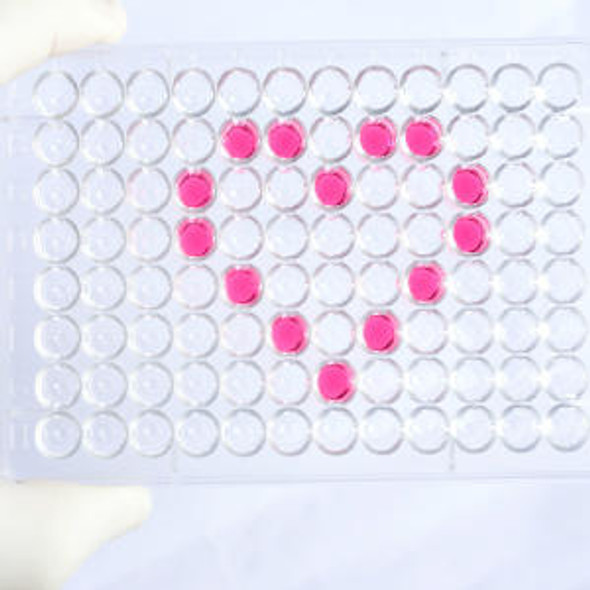Human Cell Biology ELISA Kits 3
Human MSR1 (Macrophage Scavenger Receptor 1) CLIA Kit (HUES00412)
- SKU:
- HUES00412
- Product Type:
- ELISA Kit
- ELISA Type:
- CLIA Kit
- Size:
- 96 Assays
- Sensitivity:
- 37.5pg/mL
- Range:
- 62.5-4000pg/mL
- ELISA Type:
- Sandwich
- Reactivity:
- Human
- Sample Type:
- Serum, plasma and other biological fluids
- Research Area:
- Cell Biology
Description
| Assay type: | Sandwich |
| Format: | 96T |
| Assay time: | 4.5h |
| Reactivity: | Human |
| Detection method: | Chemiluminescence |
| Detection range: | 62.50-4000 pg/mL |
| Sensitivity: | 37.50 pg/mL |
| Sample volume: | 100µL |
| Sample type: | Serum, plasma and other biological fluids |
| Repeatability: | CV < 15% |
| Specificity: | This kit recognizes Human MSR1 in samples. No significant cross-reactivity or interference between Human MSR1 and analogues was observed. |
This kit uses Sandwich-CLIA as the method. The micro CLIA plate provided in this kit has been pre-coated with an antibody specific to Human MSR1. Standards or samples are added to the appropriate micro CLIA plate wells and combined with the specific antibody. Then a biotinylated detection antibody specific for Human MSR1 and Avidin-Horseradish Peroxidase (HRP) conjugate are added to each micro plate well successively and incubated. Free components are washed away. The substrate solution is added to each well. Only those wells that contain Human MSR1, biotinylated detection antibody and Avidin-HRP conjugate will appear fluorescence. The Relative light unit (RLU) value is measured spectrophotometrically by the Chemiluminescence immunoassay analyzer. The RLU value is positively associated with the concentration of Human MSR1. The concentration of Human MSR1 in the samples can be calculated by comparing the RLU of the samples to the standard curve.
| UniProt Protein Function: | MSR1: Membrane glycoproteins implicated in the pathologic deposition of cholesterol in arterial walls during atherogenesis. Two types of receptor subunits exist. These receptors mediate the endocytosis of a diverse group of macromolecules, including modified low density lipoproteins (LDL). Isoform III does not internalize actetylated LDL. Defects in MSR1 may be a cause of prostate cancer (PC). A malignancy originating in tissues of the prostate. Most prostate cancers are adenocarcinomas that develop in the acini of the prostatic ducts. Other rare histopathologic types of prostate cancer that occur in approximately 5% of patients include small cell carcinoma, mucinous carcinoma, prostatic ductal carcinoma, transitional cell carcinoma, squamous cell carcinoma, basal cell carcinoma, adenoid cystic carcinoma (basaloid), signet- ring cell carcinoma and neuroendocrine carcinoma. MSR1 variants may play a role in susceptibility to prostate cancer. MSR1 variants have been found in individuals with prostate cancer and co-segregate with the disease in some families. Defects in MSR1 may be a cause of Barrett esophagus (BE). A condition characterized by a metaplastic change in which normal esophageal squamous epithelium is replaced by a columnar and intestinal-type epithelium. Patients with Barrett esophagus have an increased risk of esophageal adenocarcinoma. The main cause of Barrett esophagus is gastroesophageal reflux. The retrograde movement of acid and bile salts from the stomach into the esophagus causes prolonged injury to the esophageal epithelium and induces chronic esophagitis, which in turn is believed to trigger the pathologic changes. Genetic variants in MSR1 have been found in individuals with Barrett esophagus and are thought to contribute to disease susceptibility. 3 isoforms of the human protein are produced by alternative splicing. |
| UniProt Protein Details: | Protein type:Membrane protein, integral Chromosomal Location of Human Ortholog: 8p22 Cellular Component: integral to plasma membrane; plasma membrane Molecular Function:low-density lipoprotein binding; protein binding Biological Process: cholesterol transport; receptor-mediated endocytosis Disease: Barrett Esophagus; Prostate Cancer |
| NCBI Summary: | This gene encodes the class A macrophage scavenger receptors, which include three different types (1, 2, 3) generated by alternative splicing of this gene. These receptors or isoforms are macrophage-specific trimeric integral membrane glycoproteins and have been implicated in many macrophage-associated physiological and pathological processes including atherosclerosis, Alzheimer's disease, and host defense. The isoforms type 1 and type 2 are functional receptors and are able to mediate the endocytosis of modified low density lipoproteins (LDLs). The isoform type 3 does not internalize modified LDL (acetyl-LDL) despite having the domain shown to mediate this function in the types 1 and 2 isoforms. It has an altered intracellular processing and is trapped within the endoplasmic reticulum, making it unable to perform endocytosis. The isoform type 3 can inhibit the function of isoforms type 1 and type 2 when co-expressed, indicating a dominant negative effect and suggesting a mechanism for regulation of scavenger receptor activity in macrophages. [provided by RefSeq, Jul 2008] |
| UniProt Code: | P21757 |
| NCBI GenInfo Identifier: | 127357 |
| NCBI Gene ID: | 4481 |
| NCBI Accession: | P21757. 1 |
| UniProt Secondary Accession: | P21757,O60505, P21759, Q45F10, D3DSP3, |
| UniProt Related Accession: | P21757 |
| Molecular Weight: | 42,942 Da |
| NCBI Full Name: | Macrophage scavenger receptor types I and II |
| NCBI Synonym Full Names: | macrophage scavenger receptor 1 |
| NCBI Official Symbol: | MSR1 |
| NCBI Official Synonym Symbols: | SRA; SR-A; CD204; phSR1; phSR2; SCARA1 |
| NCBI Protein Information: | macrophage scavenger receptor types I and II |
| UniProt Protein Name: | Macrophage scavenger receptor types I and II |
| UniProt Synonym Protein Names: | Macrophage acetylated LDL receptor I and II; Scavenger receptor class A member 1; CD_antigen: CD204 |
| Protein Family: | Macrophage scavenger receptor |
| UniProt Gene Name: | MSR1 |
| UniProt Entry Name: | MSRE_HUMAN |
As the RLU values of the standard curve may vary according to the conditions of the actual assay performance (e. g. operator, pipetting technique, washing technique or temperature effects), the operator should establish a standard curve for each test. Typical standard curve and data is provided below for reference only.
| Concentration (pg/mL) | RLU | Average | Corrected |
| 4000 | 55385 62777 | 59081 | 59046 |
| 2000 | 25631 30087 | 27859 | 27824 |
| 1000 | 13509 13459 | 13484 | 13449 |
| 500 | 6398 6812 | 6605 | 6570 |
| 250 | 3299 3187 | 3243 | 3208 |
| 125 | 1653 1509 | 1581 | 1546 |
| 62.50 | 748 762 | 755 | 720 |
| 0 | 34 36 | 35 | -- |
Precision
Intra-assay Precision (Precision within an assay): 3 samples with low, mid range and high level Human MSR1 were tested 20 times on one plate, respectively.
Inter-assay Precision (Precision between assays): 3 samples with low, mid range and high level Human MSR1 were tested on 3 different plates, 20 replicates in each plate.
| Intra-assay Precision | Inter-assay Precision | |||||
| Sample | 1 | 2 | 3 | 1 | 2 | 3 |
| n | 20 | 20 | 20 | 20 | 20 | 20 |
| Mean (pg/mL) | 205.70 | 398.07 | 1893.94 | 188.32 | 425.69 | 1716.38 |
| Standard deviation | 20.26 | 35.83 | 199.24 | 21.24 | 44.14 | 159.28 |
| C V (%) | 9.85 | 9.00 | 10.52 | 11.28 | 10.37 | 9.28 |
Recovery
The recovery of Human MSR1 spiked at three different levels in samples throughout the range of the assay was evaluated in various matrices.
| Sample Type | Range (%) | Average Recovery (%) |
| Serum (n=5) | 87-101 | 92 |
| EDTA plasma (n=5) | 87-100 | 92 |
| Cell culture media (n=5) | 94-108 | 99 |
Linearity
Samples were spiked with high concentrations of Human MSR1 and diluted with Reference Standard & Sample Diluent to produce samples with values within the range of the assay.
| Serum (n=5) | EDTA plasma (n=5) | Cell culture media (n=5) | ||
| 1:2 | Range (%) | 95-109 | 102-120 | 95-110 |
| Average (%) | 102 | 109 | 101 | |
| 1:4 | Range (%) | 101-114 | 93-104 | 99-117 |
| Average (%) | 107 | 98 | 107 | |
| 1:8 | Range (%) | 98-117 | 96-109 | 89-103 |
| Average (%) | 106 | 102 | 95 | |
| 1:16 | Range (%) | 90-106 | 91-104 | 86-96 |
| Average (%) | 96 | 99 | 91 |
An unopened kit can be stored at 4°C for 1 month. If the kit is not used within 1 month, store the items separately according to the following conditions once the kit is received.
| Item | Specifications | Storage |
| Micro CLIA Plate(Dismountable) | 8 wells ×12 strips | -20°C, 6 months |
| Reference Standard | 2 vials | |
| Concentrated Biotinylated Detection Ab (100×) | 1 vial, 120 µL | |
| Concentrated HRP Conjugate (100×) | 1 vial, 120 µL | -20°C(shading light), 6 months |
| Reference Standard & Sample Diluent | 1 vial, 20 mL | 4°C, 6 months |
| Biotinylated Detection Ab Diluent | 1 vial, 14 mL | |
| HRP Conjugate Diluent | 1 vial, 14 mL | |
| Concentrated Wash Buffer (25×) | 1 vial, 30 mL | |
| Substrate Reagent A | 1 vial, 5 mL | 4°C (shading light) |
| Substrate Reagent B | 1 vial, 5 mL | 4°C (shading light) |
| Plate Sealer | 5 pieces | |
| Product Description | 1 copy | |
| Certificate of Analysis | 1 copy |
- Set standard, test sample and control (zero) wells on the pre-coated plate and record theirpositions. It is recommended to measure each standard and sample in duplicate. Note: addall solutions to the bottom of the plate wells while avoiding contact with the well walls. Ensuresolutions do not foam when adding to the wells.
- Aliquot 100µl of standard solutions into the standard wells.
- Add 100µl of Sample / Standard dilution buffer into the control (zero) well.
- Add 100µl of properly diluted sample (serum, plasma, tissue homogenates and otherbiological fluids. ) into test sample wells.
- Cover the plate with the sealer provided in the kit and incubate for 90 min at 37°C.
- Aspirate the liquid from each well, do not wash. Immediately add 100µL of BiotinylatedDetection Ab working solution to each well. Cover the plate with a plate seal and gently mix. Incubate for 1 hour at 37°C.
- Aspirate or decant the solution from the plate and add 350µL of wash buffer to each welland incubate for 1-2 minutes at room temperature. Aspirate the solution from each well andclap the plate on absorbent filter paper to dry. Repeat this process 3 times. Note: a microplatewasher can be used in this step and other wash steps.
- Add 100µL of HRP Conjugate working solution to each well. Cover with a plate seal andincubate for 30 min at 37°C.
- Aspirate or decant the solution from each well. Repeat the wash process for five times asconducted in step 7.
- Add 100µL of Substrate mixture solution to each well. Cover with a new plate seal andincubate for no more than 5 min at 37°C. Protect the plate from light.
- Determine the RLU value of each well immediately.






